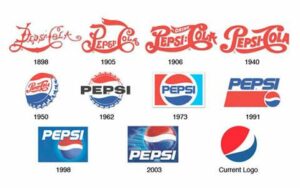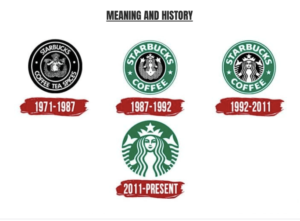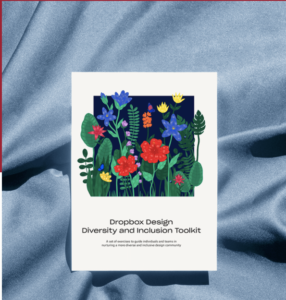4 Examples of Brand Evolution & Brand Evolution Strategies
An updated font. A slight color change. A new website layout.
If you notice these changes with some of your favorite brands, that means a strategic initiative is underway.
Companies going through a brand evolution take small steps to reinvigorate their services and appeal in the marketplace. This practice can be in response to customer insights or feedback, marketplace trends, or a proactive internal push.
A brand evolution is to not be confused with a complete rebranding effort. Learn about popular brand evolution strategies from companies like Pepsi, Starbucks, Vogue, and Dropbox.
Need help selecting a company?
Based on your budget, timeline, and specifications we can help you build a shortlist of companies that perfectly matches your project needs. Get started by submitting your project details.
Brand Evolution v. Rebrand
A rebrand is a significant change or shift in how a brand looks or presents itself. This could mean a complete logo change, a name change, or a messaging shift across other brand assets. This often comes with a relaunch or big reveal to showcase to stakeholders or customers that a change is coming.
On the other hand, a brand evolution is for companies that want to stick to their main values and maintain familiarity among consumers. They accomplish this by making small changes through a slightly different color palette, tone of voice, logo redesign, or simply promoting values from a new angle, like an awareness campaign.
Here are a few examples of brand evolution strategies that have proven effective for major brands and companies today. (And, if you need help with your next brand evolution, consider hiring a branding company.)
Brand Evolution Examples
- Logo Redesign & Pepsi
- Color Use & Starbucks
- Reflecting Trends & Vogue
- Values, Messaging & Dropbox
1. Logo Redesign & Pepsi
A logo redesign is a great way for companies to signal a small transition to their audience. Different from a complete logo revamp, businesses going through a brand evolution can change their logo by updating it to meet brand and external expectations – with the help of a logo design company, of course.
Pepsi is one of the most famous soda brands in the world. Developed in 1893, the brand has gone through several logo changes over the years.

Despite these frequent logo changes, Pepsi remains consistent since they introduced the bottle cap look in 1950 – keeping the same color scheme. The iconic red, blue, and white remain synonymous with the company.
Pepsi has successfully gone through a brand evolution while keeping its core corporate identity intact.
2. Use of Color & Starbucks
One of the most recognizable company logos is the Starbucks logo. When the trademark was founded in 1971, the founders decided to play up the marine theme to match Starbucks’ waterside location in Seattle.
While the sea mermaid has stayed the same throughout the years, there has been one key difference: color

In 1987, Starbucks’ logo became more stylized to match its growing popularity. The addition of green aimed to match the company’s dedication to modernity and its support of the environment (like green marketing). Compared to the old coffee-brown color scheme, the addition of green and white had a more soothing effect on customers.
While a color change like this may seem more significant, the change allowed Starbucks to evolve beyond selling just coffee drinks to become a global entity.
3. Reflecting Trends & Vogue
As fashion trends evolve, their staple magazines like Vogue evolve as well.
Throughout the years, Vogue has undergone a consistent brand evolution to match the needs of the fashion industry, public appeal, and innovative fashion trends.
In 1892, the first edition of Vogue was published. Dedicated to “the ceremonial side of life,” the magazine targeted high society, fashion, and culture.
As art deco became popular in the 1920s, Vogue sought to meet industry expectations while appealing to its global audience.

Using a stylistic font with toned colors, the editors wanted to appeal to consumers with a cosmopolitan flair, as seen in this 1927 cover.
In their recent magazine for April 2021, there is a strong, distinct difference in color, font, and fashion.

Along with fashion being the centerpiece of Vogue’s brand and marketing strategy, the idea of celebrity has become a cornerstone of the brand.
While fashion trends evolve frequently, the magazine seeks to put the finest on its magazine covers while sticking to its classic and timeless appeal.
4. Values, Messaging & Dropbox
A brand evolution can involve a shift in messaging as long as the company’s values remain the same.
Software company Dropbox started as a modern, cloud-storage workspace in 2007. The company’s main offerings included file-sharing, personal cloud storage, and other synchronization software.
Throughout the years, Dropbox’s services expanded. The company acquired photo and video gallery services, email applications, and a note-taking service.
Dropbox wanted to be seen as a more collaborative and creative online space.

Dropbox offers design kits, like the one above, that allow for self-exploration, team activities, and innovative discoveries.
While keeping its main message of collaboration and efficiency, Dropbox found a way to evolve through offering services that fit a range of voices and perspectives.
Companies Should Look to Evolve
A brand evolution is a great way for businesses to adapt without losing their key principles and vision.
Companies looking to go through a brand evolution can:
- Reposition their brand through an efficient logo design
- Use color to modernize and elevate their company’s look
- Strategically reflect trends in the industry by keeping up with audience evolution
- Keep their key values and messaging by offering new services for a changing world
Brand evolutions can be reactive, modern, and engaging. Businesses can ensure their brand is still recognizable by keeping their company’s value while maintaining consumer expectations.
Want help evaluating your branding needs? Connect with a branding agency or creative agency here.
Need help selecting a company?
Based on your budget, timeline, and specifications we can help you build a shortlist of companies that perfectly matches your project needs. Get started by submitting your project details.